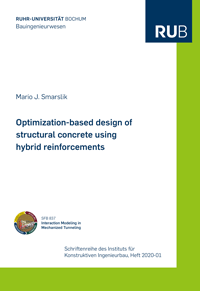
Shop : Details
Shop
Details
49,80 €ISBN 978-3-8440-7257-0Softcover252 pages154 figures375 g21 x 14,8 cmEnglishThesis
March 2020
Mario J. Smarslik
Optimization-based design of structural concrete using hybrid reinforcements
This work focuses on making the method of topology optimization more readily available for practical application in structural engineering and to fully integrate it into the design process in order to provide reliable, qualitatively and quantitatively ready-to-use reinforced concrete (RC) concepts. To achieve this goal, this thesis is divided into two main parts.
The first part focuses on the development of a topology optimization approach tailored to RC design. The approach is based on combined truss–continuum topology optimization (TCTO), which couples continuum- and truss elements in a single analysis model for a better representation of RC behavior. The methodology is advanced to facilitate optimization results that follow engineering theory and allow the consideration of steel fiber- and hybrid steel fiber–rebar reinforcements as well as robust multi-load optimization by including exclusive load case combinations.
The second part of the thesis is devoted to the practical application and experimental validation of the newly devised optimization methodology at the example of segmental tunnel lining longitudinal joints. The experiments comprise four individual series, which focus on the enhancement of the joint by employing various reinforcement- and material concepts: low-deformation, welded rebar cages; steel fibers with and without modification of their orientation; hybrid steel fiber–rebar configurations; and hybrid material schemes that combine standard materials and localized, high-performance steel fiber-reinforced concrete additions. The results provide insights into the load-bearing behavior of concrete elements under partial area strip loading and segmental lining longitudinal joints, which are subsequently transferred into practical design recommendations.
The first part focuses on the development of a topology optimization approach tailored to RC design. The approach is based on combined truss–continuum topology optimization (TCTO), which couples continuum- and truss elements in a single analysis model for a better representation of RC behavior. The methodology is advanced to facilitate optimization results that follow engineering theory and allow the consideration of steel fiber- and hybrid steel fiber–rebar reinforcements as well as robust multi-load optimization by including exclusive load case combinations.
The second part of the thesis is devoted to the practical application and experimental validation of the newly devised optimization methodology at the example of segmental tunnel lining longitudinal joints. The experiments comprise four individual series, which focus on the enhancement of the joint by employing various reinforcement- and material concepts: low-deformation, welded rebar cages; steel fibers with and without modification of their orientation; hybrid steel fiber–rebar configurations; and hybrid material schemes that combine standard materials and localized, high-performance steel fiber-reinforced concrete additions. The results provide insights into the load-bearing behavior of concrete elements under partial area strip loading and segmental lining longitudinal joints, which are subsequently transferred into practical design recommendations.
Keywords: optimization; topology optimization; structural concrete
Schriftenreihe des Instituts für Konstruktiven Ingenieurbau
Edited by Prof. Dr.-Ing. R. Breitenbücher, Prof. Dr.-Ing. Rüdiger Höffer, Univ.-Prof. Dr. Markus Knobloch, Univ.-Prof. Dr.-Ing. habil. Peter Mark and Prof. Dr.-Ing. Markus Thewes, Bochum
Volume 2020,1
Available online documents for this title
You need Adobe Reader, to view these files. Here you will find a little help and information for downloading the PDF files.
Please note that the online documents cannot be printed or edited.
Please also see further information at: Help and Information.
Please also see further information at: Help and Information.
| Document |  | Document | ||
| Type |  | |||
| Costs |  | 37,35 € | ||
| Action |  | Purchase in obligation and download the file | ||
| Document |  | Table of contents | ||
| Type |  | |||
| Costs |  | free | ||
| Action |  | Download the file | ||
User settings for registered online customers (online documents)
You can change your address details here and access documents you have already ordered.
User
Not logged in
Export of bibliographic data
Shaker Verlag GmbH
Am Langen Graben 15a
52353 Düren
Germany
Am Langen Graben 15a
52353 Düren
Germany
Mon. - Thurs. 8:00 a.m. to 4:00 p.m.
Fri. 8:00 a.m. to 3:00 p.m.
Fri. 8:00 a.m. to 3:00 p.m.
Contact us. We will be happy to help you.



